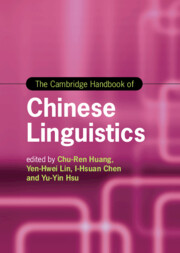Book contents
- The Cambridge Handbook of Chinese Linguistics
- Cambridge Handbooks In Language and Linguistics
- The Cambridge Handbook of Chinese Linguistics
- Copyright page
- Contents
- Figures
- Tables
- Contributors
- Acknowledgments
- Part One Writing System/Neuro-cognitive Processing of Chinese
- Part Two Morpho-lexical Issues in Chinese
- 3 Wordhood and Disyllabicity in Chinese
- 4 Characters as Basic Lexical Units and Monosyllabicity in Chinese
- 5 Parts of Speech in Chinese and How to Identify Them
- 6 Gaps in Parts of Speech in Chinese and Why?
- 7 Derivational and Inflectional Affixes in Chinese and Their Morphosyntactic Properties
- 8 The Extreme Poverty of Affixation in Chinese
- 9 On an Integral Theory of Word Formation in Chinese and Beyond
- 10 Compounding Is Semantics-driven in Chinese
- Part Three Phonetic-phonological Issues in Chinese
- Part Four Syntax-semantics, Pragmatics, and Discourse Issues
- Index
- References
10 - Compounding Is Semantics-driven in Chinese
from Part Two - Morpho-lexical Issues in Chinese
Published online by Cambridge University Press: 04 August 2022
- The Cambridge Handbook of Chinese Linguistics
- Cambridge Handbooks In Language and Linguistics
- The Cambridge Handbook of Chinese Linguistics
- Copyright page
- Contents
- Figures
- Tables
- Contributors
- Acknowledgments
- Part One Writing System/Neuro-cognitive Processing of Chinese
- Part Two Morpho-lexical Issues in Chinese
- 3 Wordhood and Disyllabicity in Chinese
- 4 Characters as Basic Lexical Units and Monosyllabicity in Chinese
- 5 Parts of Speech in Chinese and How to Identify Them
- 6 Gaps in Parts of Speech in Chinese and Why?
- 7 Derivational and Inflectional Affixes in Chinese and Their Morphosyntactic Properties
- 8 The Extreme Poverty of Affixation in Chinese
- 9 On an Integral Theory of Word Formation in Chinese and Beyond
- 10 Compounding Is Semantics-driven in Chinese
- Part Three Phonetic-phonological Issues in Chinese
- Part Four Syntax-semantics, Pragmatics, and Discourse Issues
- Index
- References
Summary
Current studies of semantic word formation of Chinese compounds aim to work out collocational patterns and semantic patterns. In addition to investigating the surface semantic relations among the composing morphemes of compound words, researchers adopt the methods of semantic-syntactic analyses of sentences and study the predicative relation among the composing morphemes. Rather than introducing argument structure, it might be better to make use of qualia structure to analyze the semantic structure of nominal compounds.
- Type
- Chapter
- Information
- The Cambridge Handbook of Chinese Linguistics , pp. 198 - 220Publisher: Cambridge University PressPrint publication year: 2022



